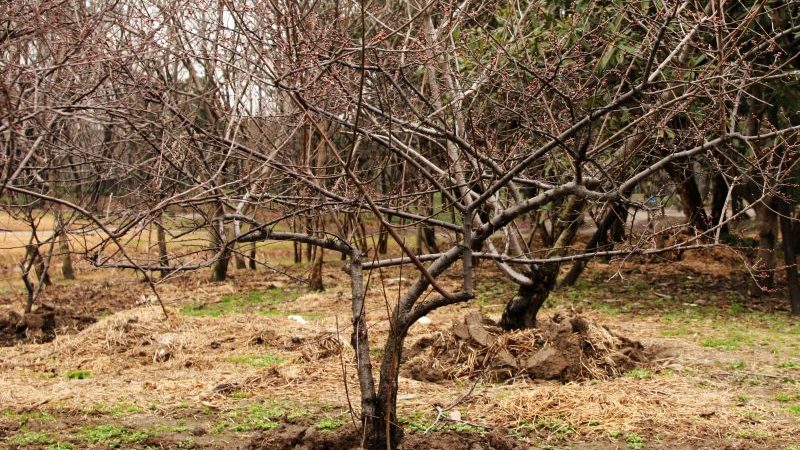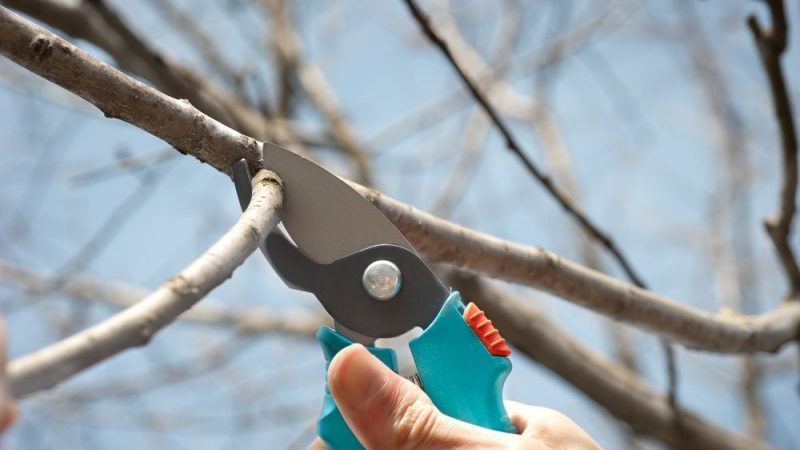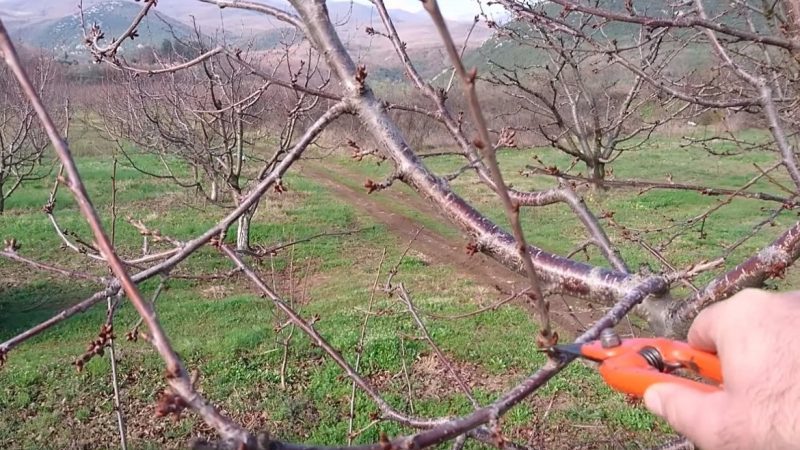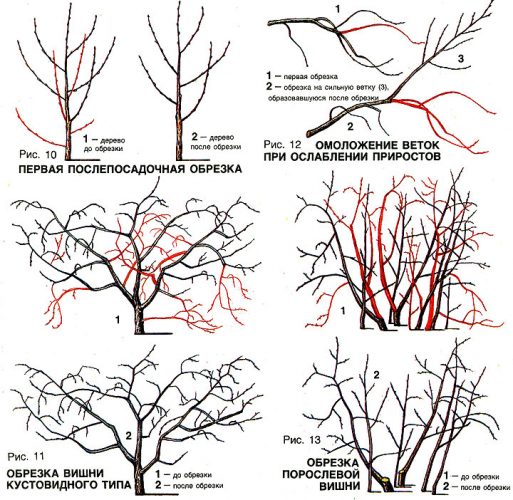What cherry care should include in fall: a guide from experienced gardeners
Cherry is an extremely hardy crop, resistant to low temperatures and other adverse conditions. However, proper care of the plant before the coming frosts is the key to a good harvest in the future.
How to care for cherries in the fall, how to treat pests and how to insulate a tree - we will tell in the article.
The content of the article
Features of cherry care in autumn
In the autumn, the growth of young shoots stops at cherry. But it is during this period of growth dormancy that future flower buds are born, and lignification of the trunk occurs. In order for the spring flowering to be successful, the plant's energy supply is replenished in advance with the help of fertilizers.
In the autumn, pests are activated before hibernation. They successfully fix on a tree trunk, hibernate there, and wake up at temperatures above + 15 ° C. Moreover, they can lay eggs in the tree, from which offspring will develop in the future. Effective ways to control pests are thorough inspection of the trunk and its treatment with fungicides and insecticides.
With the approach of cold weather, the cherry needs to insulate the roots - otherwise they can be damaged by severe frosts.

How to properly care for cherries in the fall
It is impossible to get a high-quality harvest without caring for the tree. Most of the work is carried out in the fall.
Digging the soil around
Turbulence of the trunk circle affects the cherry negatively. To avoid this, in the summer, they mulch the ground around the tree, and in the fall they dig it up.
Important! Do not dig deeper than 15 cm so as not to damage the roots of the tree.
Watering
After digging and loosening the soil around the tree, the soil is watered. At least 2 buckets of water are poured under each plant with a temperature higher than the air temperature outside at the time of watering.
The area of the near-trunk circle is limited by a trench so that water does not spill. Thus, moisture reaches the roots of the plant, which is especially important in winter, because the moist earth freezes more slowly.
Top dressing
Fertilization supports the plant in the soil in the autumn... Nitrogen is not added to the cherry fertilizer as it triggers the growth process and reduces the plant's ability to withstand cold temperatures.
Gardeners use compost (for young trees up to 7 years old - 2 kg per 1 m² of the trunk circle, for older trees - 3 kg). The best combination is phosphorus + potassium. Non-fertile trees - 2 tbsp. l. superphosphate and 1 tbsp. l. potassium chloride, fruiting - 3 tbsp. l. superphosphate and 1.5 tbsp. l. potassium chloride.
Pruning

Pruning increases yields and reduces the risk of disease. Pruning is carried out in two ways: by the thinning method - the branches of the tree are cut off at the base or by the shortening method - not all of the branch is cut off.
Pruned before the onset of frost. Dates depend on the specific region: from September to November... Places of cuts are treated with garden pitch.
Important! If the wounds that appeared on the trunk during sanitation do not have time to heal before winter, there is a risk that the tree will get sick.
Several branches from a plant are not removed in one procedure. It is stressful for the plant, which contributes to the appearance of diseases.
Whitewash
To prevent possible frostbite of the cherry trunk if sudden frosts come, the stems of young cherries are wrapped with burlap, spruce branches or newspapers. The bases of the trees are wrapped with a plastic net that protects against rodents.
Mature trees are whitewashed. It protects cherry trunks from the negative effects of sunlight and frost, repels insects and small rodents.
Garbage collection
In the autumn, before and after pruning, garbage is removed from the trunk circle. Dry branches and fallen leaves rot and negatively affect the quality of the soil. It is important to get rid of them in time so that pests and pathogens cannot overwinter in them.
Protection against diseases and pests
Important actions in processing wood from pests and diseases:
- processing of cherries with urea;
- getting rid of fallen leaves around the tree;
- treatment of wounds and cracks in the trunk;
- applying garden varnish to pruning sites;
- pruning dry, diseased and broken branches;
- spraying the tree with preparations against garden pests, for example, copper sulfate or cypermethrin, which has a wide spectrum of action (cypermethrin is a part of the preparations Tsifox, Mustang, Arriro, Inta-Vir).
How to prepare a tree for winter

So that the buds on the cherry do not freeze, and the roots and trunk do not suffer from temperature fluctuations, the tree is prepared for the winter period as follows:
- The branches are bent down. Old and dry ones are removed.
- Cover the pressed branches with straw or tops.
- Cover the soil under the tree with a thick layer of snow if it has already fallen out. Sometimes they scoop up the snow, creating a snowdrift.
- Cover the barrel with a burlap cover or wrap with paper.
Care features
Care differs depending on the age of the cherry, the region of its cultivation, the selected type of fruit tree.
According to age
Cherries up to 3 years old do not need fertilizing with minerals, since they do not yet bear fruit. Old cherries are fed every year, as they spend a lot of energy on fruiting and spend all supplies during the summer season.
Pruning young trees in the autumn is carried out extremely carefully. They are still weak, a large haircut will weaken and destroy the seedlings.
Depending on the region
Suitable regions for the growth and fruiting of cherries are Ukraine, Belarus, the south and central regions of Russia. Growing in the Urals, Siberia and the Far East involves the choice of adapted varieties and the specifics of care:
- in cold climates, the way of sheltering cherries is important, since not only the trunk of plants freezes, but also the buds;
- bush cherries require bent branches to be completely hidden by snow;
- for standard varieties, they insulate the trunk, protect against rodents and other pests;
- in Siberia, it is preferable to plant cherries from a stone, otherwise it will not take root;
- in the middle lane cherries suffer from moniliosis, regular treatments before flowering with the fungicides "Horus" or "Skor" is an obligatory stage of care.
Depending on the type
Cherry tree species are also important when determining how to care:
- Steppe cherry is resistant to low temperatures. In winter, it is enough to bend the branches and cover them with snow. Such a cherry is self-fertile, so a few more cherries are planted next to it. Strong root system that is used for further propagation.
- The homeland of Sandy Cherry is North America. Cherry is not demanding on climate conditions; it loves bright places and permeable soil. Resistant to frost and drought.
- Ferruginous cherry first appeared in Korea. Loves bright places. Strong frosts harm young shoots, therefore, requires careful insulation and shelter.
- Gray cherry is drought tolerant, but suffers severely from frost. Such a cherry grows slowly. Loves bright sunny areas and well-drained soil.
Experienced gardening tips

Experienced gardeners for the cultivation of a prolific plant recommend:
- Do not buy trees from your hands and do not save on buying a seedling.The tree lives for a long time and will bear fruit for more than one year. It is better if it is initially a healthy plant.
- Plant your tree near fences to keep out the wind.
- Choose an area for planting with little moisture in the soil. Avoid waterlogging.
- Carry out the main garden work 1-1.5 months before the first frost.
- For autumn planting spud the young specimen with earth to a height of 30-35 cm.
- Before planting, place the cherry root system in a solution of humus and clay to improve survival.
- Do not use fresh manure as fertilizer, as it burns the plant roots.
It is interesting:
Why are gardeners so fond of growing Cherry potatoes?
A step-by-step guide to fermenting currant leaves for tea.
A selection of the best varieties of the most delicious winter-hardy pears for Siberia.
Conclusion
Following the rules for caring for cherries will allow you to grow a healthy tree with bright juicy berries. Top dressing, pruning, watering and insulation carried out on time will increase the yield of the tree, prevent the appearance of pests and diseases.